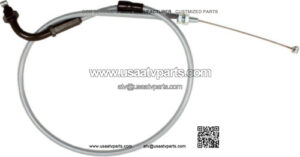Clutch Cables – Four Signs Of Damage
“A clutch cable is the steel braided cable found on manual transmission vehicles that connects the transmission clutch linkage to the clutch pedal mechanism. When the pedal is depressed, the clutch cable pulls on the clutch linkage to disengage the clutch so that the transmission can be safely shifted.”
The clutch cable connects the pedal to the clutch mechanism; it’s responsible for transferring the pedal movement to the clutch system. According to the Automobile Association (AA), clutch cable damage is one of the top ten causes of car breakdowns. If you don’t want to be stranded and forced to all for a tow truck, then you have to be on the lookout for the symptoms of clutch damage, which include:
Slipping Gear
Just like the term suggests, transmission slipping ours when your car’s gears shift without you moving any lever or pedal. It usually happens when the clutch cable is worn out or too stretched, causing it to move when the engine is straining, for example, when going uphill. This is a dangerous symptom because your parked car can suddenly start moving without any apparent cause.
Leaks
A visual inspection of the clutch system may sometimes reveal a leaking clutch cable. If there is a leak, then it means either your clutch cable is merely detached (a fortunate problem because the fix just involves reconnecting it) or that it is broken. This latter problem calls for the replacement of the cable.
Difficulty in Shifting
If your clutch cable is stretched beyond its limit or broken, then your car will act as if it doesn’t have a clutch altogether. This means that it will not be possible to execute common clutch operations, such as shifting. In such a case, your car won’t move when shifted into gear. Hopefully, you won’t let your clutch problems come to this point.
Stuck Clutch Pedal
A clutch pedal may get stack if the cable suddenly snaps while you are depressing it. The pedal will remain stuck on the floor, and you won’t be able to operate the clutch system (meaning no shifting of gears). This is one of the reasons you should be very keen while depressing the clutch pedal, and it feels too stiff, especially if you have noticed other symptoms of clutch trouble before.
Such a cable needs to be replaced. Don’t forget to take a test drive after the replacement to confirm that the new cable has been properly installed. This is the case if the clutch engages in the middle of the pedal stroke.
It’s clear that clutch cable damage isn’t something you can afford to ignore. Since some of these symptoms may also be occasioned by other problems, you ought to have your suspicion confirmed by a professional mechanic before replacing your clutch cable.
About atv clutch cables
“atv clutch problems”
“atv clutch replacement”
“atv clutch tool”


